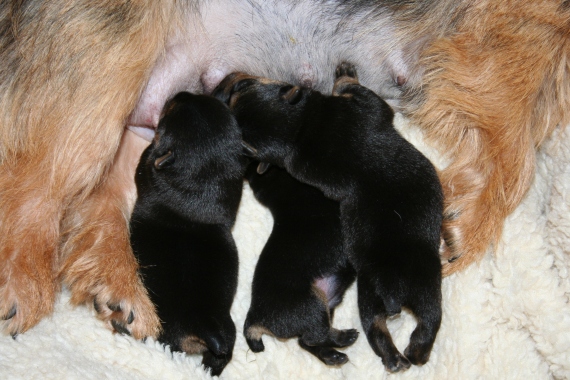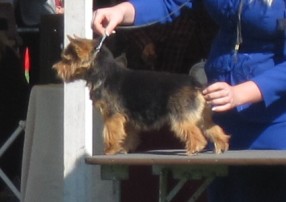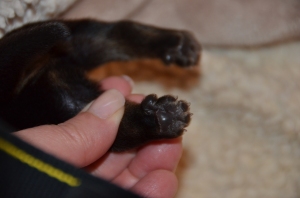Why Are Norwich Terrier Tails Docked?
Norwich Terrier has been historically a docked breed. The most commonly quoted reason for docking is avoiding tail injury during hunting in thorny underbrush. Another reason frequently given is having a tail length that allows for grabbing a dog while it hunts in a burrow and might need help being pulled out fast during a dangerous encounter with its inhabitant, or when a burrow collapses. However, more recently another reason came to prominence and that is docking a tail as a way of ensuring a right to do so, and by extension a right to breed purebred dogs and to own multiple dogs. In other words “nobody can tell me what to do” argument.
Tail Docking Ban

European Norwich Terrier “Morris” (Glenmorangie From Ashprey) with a gorgeous natural tail – bred by Bea Hekman and owned by Thea van Schie
About 15 years ago Great Britain, European Union and Australia forbid tail docking and ear cropping in dogs. That ban was spearheaded by animal rights movement and struck a cord with a veterinary community and a general public.
Although the push for the ban was met with a wide spread support, it is rumored to have originated from a fringe source. When you talk about animal rights things get murky. On one hand, who can object to humane treatment of animals and laws assuring such treatment? On the other hand, there are vocal extremists who believe that any animal ownership should be outlawed. That position might not be the one shared by a majority of by and large pet owning public, but this extreme view is disproportionately over-represented within animal rights movement. In summary, as crazy as it may sound, ban on tail docking is seen by many breeders as a stop en route outlawing pet ownership. And that makes for a fiercely politicized and emotionally charged debate over tail docking within breeder community in America.
Against that backdrop, it is difficult to objectively consider tail docking but I’ll give it a whirl.
The Nitty-Gritty Of Tail Docking
Tail docking typically takes place between 3rd and 5th day of puppy’s life, either performed by a vet or by a breeder. There are advantages to both. A vet is by definition better equipped to deal with any possible complications (which are thankfully rare but almost always fatal), usually makes a cleaner cut and puts stitches at the site of the tail amputation. Breeders usually do not use stitches, and depending on the method of amputation (cutting, twisting or banding) leave less clean-cut edge. The advantage of having an experienced breeder perform the docking has to do with not having to travel to a vet’s office. In addition to an added stress of travel, and longer separation from the dam, the puppies can be exposed to various pathogens from sick animals visiting a vet that day.
The procedure is rather minor and majority of puppies recover almost immediately, certainly within minutes. They feel pain and please do not let anyone fool you into thinking otherwise, however, it is not nearly as painful as recovery from spay for example, organ removing procedure that a general public accepts without batting an eye.
The Practical Side of Things
Breeding With Tails
Removed tail takes away a concern for its inheritable characteristics. Breeders of docked tail breeds do not have to consider such things as a tail length, thickness, bushiness of coat, or how it is carried when pairing two dogs for mating. That’s one less thing to worry about in breeding decisions, for better or worse.
The Profile
Although the chances are that a Norwich Terrier puppy born in the 21st century will never have to be pulled out from a burrow, or rescued from a thorny bush during a hunt, there is a familiar outline, a profile breed aficionados love. A docked tail is a part of that “breed type” to many. It is more an emotional than a rational justification for tail docking, but nevertheless a very strong one.

GCh. Dignpop Dash of Panache – a traditional docked tail profile that spells “Norwich Terrier” to American breeders
The Tail Length
The official AKC breed standard describes “tail medium docked. The terrier’s working origin requires that the tail be of sufficient length to grasp. Base level with topline; carried erect”.
If you take this description on a face value, including its spirit of respecting the breed’s origin, and the need for the tail to be long enough to grasp it, then a natural tail does not deviate from this description any more than a tail docked too short. In terms of practicality a longer tail is more graspable than a little bob you need pincers to grab, and unfortunately a tail docked too short is a common fault in the breed.
Especially inexperienced breeders tend to dock a puppy’s tail too short, either forgetting or not understanding that necrotic tissue at the amputation site will be shrinking and eventually making the tail look shorter than when originally docked.
The Club
In 2006 Norwich and Norfolk Terrier Club of America sent a ballot to its members to vote on a change to the official breed standard regarding the tail length. It was a roundabout way to allow a natural tail, with bias, as the proposed wording was “tail medium docked, strongly preferred”. The vote on the amendment won a popular vote but failed to get 2/3rd of the required votes for the measure. After NNTC split into Norwich Terrier Club of America and Norfolk Terrier Club, the discussion on tails was opened again within NTCA and a change to the breed standard was again defeated. In other words, Norwich terriers, when shown in a breed ring in America are supposed to have docked tails.
Puppy Buyers and Veterinarians
Meanwhile, a general sentiment against docking is becoming more prominent among puppy buyers and veterinarians. Most veterinary associations, including American Veterinary Medical Association (the leading vet organization in this country) are opposed to ear cropping and tail docking in pets for cosmetic reasons, meaning when the procedure is not done for any medical reason or any clear benefit to the patient. Since 2006, in its official statements AVMA talks about the inherent risks and the pain associated with the procedure. More and more vets are willing to risk even their long time relationships with breeder clients and are refusing to dock tails.
Dogs And Breeders
Whether you call a reason for tail docking in a Norwich Terrier “cosmetic” or “traditional” that is exactly what it is. There are no practical benefits to the dog, and some scientists argue that a dog with a cropped tail is disadvantaged and has to compensate for a tail’s function to balance movement during turns and swimming.
There is a human side of things as well of course, that of a breed community. At this time a decision whether to dock a tail or not is not straightforward or easy.
Dew Claws
Front
Dew claws, which are doggy thumbs, are not referenced in the Norwich Terrier breed standard. Many breeders automatically remove dew claws either right after birth or during tail docking. When probed for reasons, most say it is to prevent possible future injuries to dew claws, which can be caught on things and torn. However, any statistics regarding dew claw injury does not support a drastic measure of removing that body part. Dew claw injuries happen but not nearly as often as to warrant dew claw removal, especially when you consider the negative implications of the procedure.
A front dew claw is attached to 5 tendons. Each of those five tendons have a muscle on the other end. When a dew claw is amputated, those five muscle bundles become atrophied from disuse. That in turn leads to added stress on the wrist during running and turning, because the function of the muscles attached to front dew claws is to support the lower leg and prevent torque during turning as the dew claw digs into the ground. If the dog does not have a dew claw, the leg twists. A life-time repetition of twisting results in carpal arthritis or significant front leg pain.
Dr. Chris Zink, a world renowned veterinarian specializing in sport injuries in dogs, has reported that in her years of treating performance-related injuries and examining dogs with chronic carpal arthritis, all but one of the affected dogs had their dew claws removed in puppyhood.
Rear
Occasionally a Norwich Terrier puppy is born with additional digits in its hind legs, referred to as “rear dew claws”. Those should not be confused with front dew claws described above, which are first digits (think thumbs). Rear dew claws are truly vestigial digits without function and should be removed in the first week of life.
To read Dr. Zink’s description of the front dew claw function click here



I enjoy your writing and appreciate all the information!
LikeLike
That was fantastic writing! It gave me a lot of information.
LikeLike